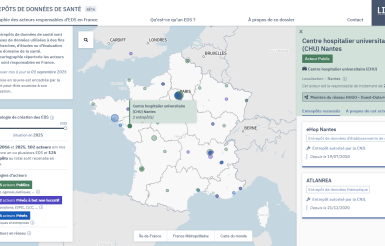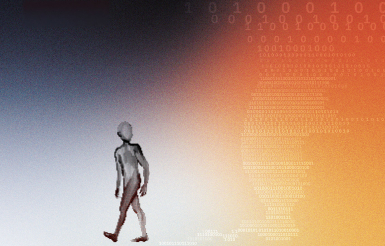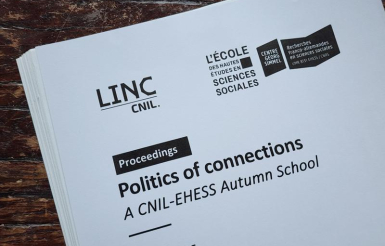Survey: the French and post-mortem data
Rédigé par Martin Biéri
-
25 November 2025At the end of 2024, as part of the drafting work for Innovation and Foresight Report No. 10, ‘Our Data After Us’, the LINC launched a survey with Harris Interactive – Toluna to explore how French people relate to post-mortem data.

This survey was conducted online between November 20 to 26, 2024, among a sample of 2,112 people aged 18 and over, using the quota method based on the respondent’s gender, age, socio-professional category, region, and size of the place of residence. Its aim was to explore their relationship to the loss of digital content and to exposure to online ‘post-mortem content’. In a more forward-looking perspective, it examined the possibilities of digital immortality through AI systems (such as deadbots, conversational agents trained on data from deceased individuals).
Losing digital content: a common experience for the French, who are aware of available solutions
The first part of the survey focused on digital use and attitudes toward the loss of digital content. Eighty-one percent of respondents said they had already lost digital content (including 8% who said this happens frequently). This is especially true among younger people (88% of those aged 15–24; 90% of those aged 25–34), who are also the ones who report being proficient with digital tools and frequently using social networks. One possible hypothesis is that the more users produce content, the more likely they are to lose some of it — but also that the more substantial their online production is, the stronger their attachment to the content, making its loss feel more problematic.
To compensate for these losses, physical storage devices are the most widely used: storing data on an external USB device (a flash drive) remains the most common option, followed by storage on an external hard drive. Digital literacy, however, is a key factor in the choice of storage methods. For example, cloud storage (hosting data on remote servers) shows the largest gap between respondents who say they are proficient with digital tools (45% use the cloud) and those who say they have little or no proficiency (17%). Paper printing shows a broad, cross-category popularity (around 50% of respondents) and is the method with the smallest gap between people who consider themselves digitally proficient and those who do not (53% versus 42%). Although ‘immaterial’ (online) storage solutions are less widely used, this may be because they are less well known and less widely mastered, even though they are increasingly integrated into mainstream consumer services (via smartphones, personal computers, etc.).
Regarding the ‘photo memory’ feature offered by major digital service platforms, the survey shows that three quarters of respondents find it appealing—mainly for remembering past events, but also for sending memories to relatives and, to a lesser extent, for rediscovering photos of deceased relatives. Here again, the motivations for using these features vary by age (personal reminiscence for older respondents, sharing for younger ones), showing that these tools contribute to sustaining and enhancing a continuous form of memory.
- See Individual practices for preservation in the IP Report (page 41) for further details.
The post-mortem existence of content published online: a prospect that divides and frightens
Nearly one third (31%) of respondents reported encountering content on social networks from the account of a deceased person (17% said this had happened several times). Some 29% said they had received automatic notifications from a deceased person’s account, while 28% reported having interacted (sharing, ‘liking’, favoriting, etc.) with content from a deceased individual. These experiences are much more common among younger people, who are more active on social networks: 52% of those aged 18–24 and 56% of those aged 25–34 reported encountering such situations.
When it comes to account management, 30% of respondents reported having interacted with a deceased person’s account. For 16% of them, the main action was saving photos and videos to preserve them. For 11%, it involved managing the account closure; for 9%, sorting through online content; and, finally, for the same proportion (9%), posting content (a message or photo) from the deceased relative’s account.
Regarding people’s wishes for their own content after death, 78% of respondents indicated that they would like some of their posted content to no longer be visible after they die (52% would prefer nothing to remain at all, and 26% would like at least a selection to be removed). The desire for content to disappear completely is stronger among women (57%, 10 points higher than men at 47%) and older individuals (66%, 14 points above the average). Conversely, social network users and tech-savvy individuals (those proficient with digital environments, familiar with GDPR, etc.) are more likely to prefer keeping content visible or selectively managing it rather than having it disappear—possibly reflecting the point mentioned earlier: the more one produces content online, the stronger the attachment to it and the greater the desire to preserve it. Similarly, another hypothesis could be that those most proficient with digital tools already regularly curate their content or choose in advance what they want to leave online.
Regarding deletion or curation, half of the respondents believe that it could be the responsibility of relatives or descendants to handle it—14% would entrust the task to a trusted third party, and 13% to the platform hosting the content. At the same time, 22% of respondents said they would prefer to manage it themselves in anticipation of their death.
- See A preference for deletion, Generational and gender differences and Reluctance to configure ante mortem in the IP Report (pages 15 and 16) for further details.
Immortality through AI: a prospect that divides opinion while sparking curiosity among some French people
The final part of the survey focused specifically on recent tools based on artificial intelligence systems that can replicate the behaviors of deceased individuals (for example, in the form of a chatbot, using the digital data available on that person—photos, videos, recordings, writings, etc.). In this context, a minority of respondents—though not negligible—seem willing to continue interacting with deceased relatives: only 8% said they would ‘definitely’ accept the idea of themselves or their relatives feeding an AI system with their data so that it could ‘outlive’ them, while 20% said they would ‘probably’ accept it. Even fewer respondents were willing to interact with such an AI themselves to stay in contact with deceased relatives (7% would definitely accept it, and 16% probably).
The majority of respondents therefore seem to distance themselves from the use of these systems: 72% would refuse to feed an AI, whether themselves or via a relative (47% would definitely refuse). Even more, 77% reject the idea of interacting with such an AI to stay in contact with deceased relatives (52% would definitely refuse).
As with previous points, age and gender appear to play a role. Indeed, while a quarter of respondents said they would accept the idea of using AI to continue interacting with their relatives, notable disparities emerge: 41% of those aged 25–34 would be favorable, compared with only 8% of those aged 65 and over. Similarly, there is a 13-point gap between men and women, with men being more inclined to use this type of AI (regardless of the scenario presented). Finally, it is interesting to note that being a parent of a child still living at home seems to increase acceptance of this type of AI: 37% of respondents in this situation would agree to feed an AI during their lifetime for the benefit of their relatives, compared with 21% of respondents without children at home.
Although initial rejection is predominant, the results suggest that practices are not fixed, with acceptance of these systems positively correlated with social network usage and previous exposure to post-mortem content.
- See A perspective that divides opinion while showing signs of gradual familiarization in the IP Report (page 34) for further details.
Download the study in French (PDF)



